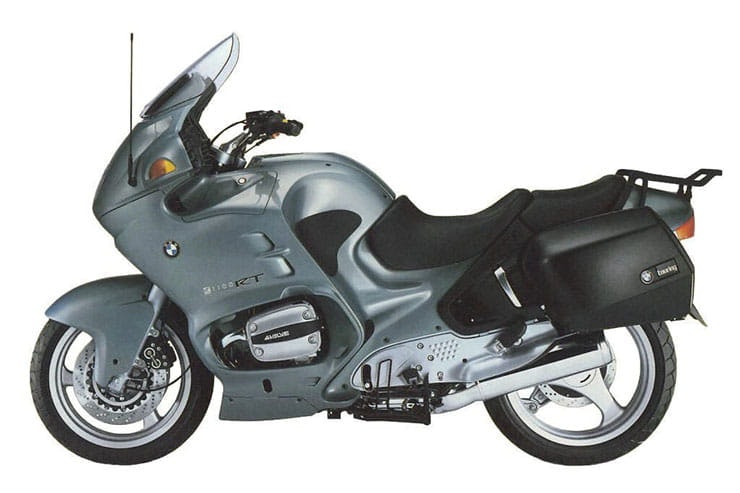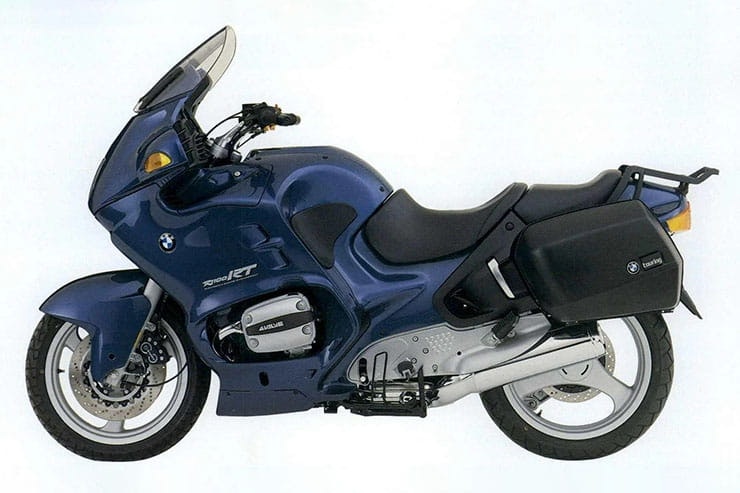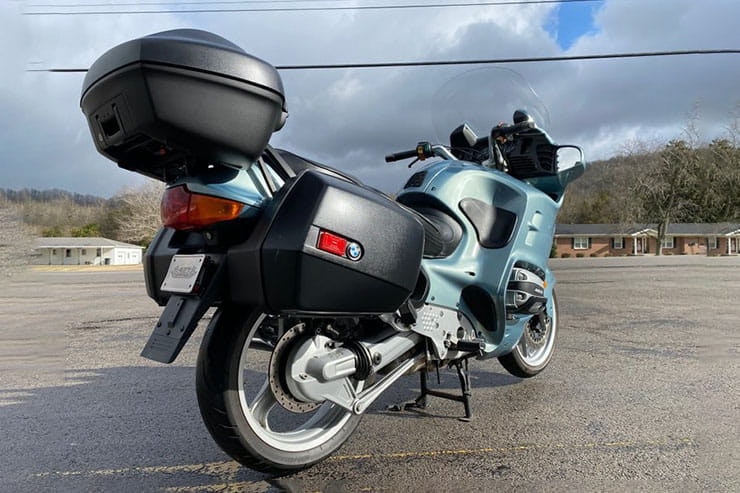BMW R1100RT (1995-2000): Review & Buying Guide
By Jim Moore
Bike journo for a quarter of a century
28.11.2023
Price: £1500-£4000 | Power: 90bhp | Weight: 256kg | Overall BikeSocial Rating: 4/5
The flat-twin boxer layout has been BMW’s favoured engine type for decades. In the mid-to-late ’90s, in 1100cc form, the German marque’s signature architecture powered everything from nakeds (R1100R) and adventure bikes (R1100GS) to sports tourers (R1100RS) and full-dress mile-munchers.
The latter appeared in the guise of the R1100RT (T for touring), and was then the latest in a long line of Bavarian boxer-twin tourers. This era of BM two-potters are affectionately known as ‘oil-heads’ on account of their two-pronged air/oil cooling. And even now, almost 30 years on from this particular RT’s launch, many boxer fanatics cite the 1100 as a better bike than its 1150cc replacement on account of its simpler and less problematic tech, as well as being more characterful than BM’s four-cylinder K models.
At 256 kilos dry (nearer 270kg when gassed) the RT is a big unit – in fact, it was the heaviest bike BMW had produced at that time. But once on the go it’s well balanced, carries its bulk well and is the perfect perch for both rider (3-way adjustable) and pillion to rack up huge mileages. A massive fairing provides supreme protection from the elements, as well as being stuffed full of useful tech like an electric screen, stereo and speakers, hand warming vents, a 12v power point and several storage pockets. Then there’s the sumptuous seats, low maintenance shaft drive, grunty torque-rich motor, plus generous luggage capacity (33 litres per side), and it’s little wonder this venerable BM twin is still such a popular, sought after modern classic tourer.
BMW R1100RT (1995-2000) Price
The 1100RT ran in BMW’s range from mid-’95 to a final SE model in 2000. Basic specification remained the same throughout, with colour changes and the all-options-added SE being the only changes. Values depend more on mileage, condition and spec level than age. FSH, minimal mileage and unblemished standard condition apply to anything mint.
1995 BMW R1100RT: On sale from Sept ’95. Full dress touring variant of the 1100 boxer range, based around the sports touring RS model. Electric screen, 33-litre panniers as standard, 256kg dry. 90bhp and 69lb.ft. Colours: blue, red, green.
1996 BMW R1100RT: No technical changes. Colours: blue, red, green.
1997 BMW R1100RT: No technical changes. Colours: blue, red, green.
1998 BMW R1100RT: No technical changes. Colours: blue, red, grey, green.
1999 BMW R1100RT: Again, no technical changes. SE model appeared in 2000 as the last of the line before the 1150RT’s launch. SE denotes special equipment – BMW threw all options at the bike in one last push before the bigger model took over. Colours: silver, black, green.
R1100RT values:
Rough: £900 - £1100
Tidy: £1300 - £2500
Mint: £3000 - £4000
Cheap, capable full-dress tourer
Suffers less issues than the later R1150RT
Comfortable, characterful and relatively simple to work on
Gearbox and clutch issues
Inconsistent fuelling
Potentially expensive if big things go wrong
BMW R1100RT (1995-2000) Engine and Performance
BM’s boxer-twins of this era retain a basic charm – they vibrate, but not annoyingly so, and the gearboxes can clunk, requiring a learned technique before they’ll select ratios at their best. At cruising speed an 1100RT feels relaxed, thrumming away to itself as it efficiently and effectively clicks off the miles. If you’re coming off inline-fours looking for something with more charm, take a test ride first to be sure a boxer-twin is for you.
What this engine layout does brilliantly, however, is punch out of bends and effortlessly blast past slower traffic, often without any need to disturb the gearbox. Stick it in top (fifth) and let 69lb.ft of torque to do all the work. That said, the RT’s Bosch fuel injection system can spoil the ride. Jerky, inconsistent fuelling is a known trait of these RTs (and boxer twins of this era in general) and it’s most noticeable between 3000-5000rpm – so basically bottom end to midrange. There are cures (see What to look for) so all is not lost. But, again, try before you buy.
Reliability is a big plus with the 1100RT. Max output is less than 100bhp, so the unit isn’t stressed or over-tuned, and even the extra bulk it has to push along doesn’t put the engine under undue strain. Updating the old 980cc R100 motor into the 1085cc R1100 unit required a significant overhaul from its previous spec, however. Four-valve heads provide greater gas flow than the previous two-valve arrangement. A rise in compression from 8.45:1 to 10.7:1 gives a far more efficient mixture burn, and an increase in bore size from 94mm to 99mm created the extra cee-cees.
BMW R1100RT (1995-2000) Handling & Suspension
The RT’s chassis is typically and unmistakably BMW. A steel backbone frame utilises the engine as a stressed member, while at the front damping is controlled by the German firm’s non-adjustable Telelever set-up which uses a single shock (or strut) rather than conventional telescopic forks. The rear Paralever set-up combines a shaft final drive with a single shock, and comes with preload and rebound damping adjustment.
The Telelever system uses a wishbone, on which the damper is mounted, to connect the forks to the chassis, and dramatically reduces dive under braking. Although it feels quite different to conventional forks, once you get used to the way it reacts over bumps it’s actually a really effective set-up.
The mid-’90s was a breakthrough era for the R models, mainly down to this chassis and suspension package. R and GS models in particular are known for nimble, predictable and stable handling – a trait that fed through to the similarly designed RT. And despite its extra weight the RT is far better through twisties than its spec sheet and outward appearance may suggest.
Braking is taken care of by twin 305mm discs and four-pot Brembo calipers up front and a single 276mm disc and twin-pot caliper and the rear. It’s a modest set-up by modern standards, although adequate for the job if both ends are used to slow the sizeable payload above them rather than relying solely on the front. BMW was an early adopter of ABS technology and the R1100RT features the firm’s mechanical ABSII set up which, many owners claim, is far less troublesome than the later R1150RT’s ABSi system.
BMW R1100RT (1995-2000) What to look for
Surging: R1100 models – RT included – are notorious for fuel surging, which is most noticeable on a neutral throttle between 3000-5000rpm. This annoying trait can be cured or at least vastly improved by fitting a Techlusion fuel controller which works by piggybacking the EFI controller and monitoring signals fed to the injectors. It then adjusts fuelling according to rpm, reducing surging. The fuel controllers are made and sold by dobeckperformance.com in the States and cost $199 a pop.
Clutch: The RT features a car-style, dry, single-plate clutch. Slippage can be an issue, so get a test ride. Be mindful of noisy operation too because the splines can wear on higher mileage bikes – a replacement clutch is an expense you could do without on a fresh purchase.
Transmission: RT gearboxes are clunky and rather agricultural in feel, so don’t be too alarmed if you’re more used to slick, light Japanese transmissions. If downshifts between third and second are difficult or overly clunky the input shafts could be on their way out – again, not a job you really want to be faced with on a fresh purchase. The shaft final drive can cause issues, too. Check for leaks; these could signal failed internal seals. Play in the shaft drive will result in clunky operation. In order to determine wear, stick the bike on its centre stand and check for movement with the wheel in 3, 6, 9 and 12 o’clock positions. Any back and forth play should be minimal at most. Replacement isn’t cheap.
Throttle body sensor: Also known as the Hall Effect Sensor, this piece of kit monitors throttle body position in relation to the amount of fuel required at specific rpm. If the sensor is on its way out the bike will either misfire or stop altogether. Replacements can be had for between £80-£100.
Suspension struts: Most RTs will by now, on account of age, have been treated to either refreshed front and rear shocks or aftermarket replacements. The consensus amongst owners is that aftermarket parts are better. If a previous owner has already made the swap you’ll save yourself a few quid. If not, there are plenty of quality options available, from YSS (£339 front, rear £350 from brooksuspension.co.uk), and Nitron (£550 front and rear again from Brook).
ABS: The 1100RT’s ABS system (ABSII) is considered to be more reliable than the newer 1150RT’s ABSi set up because the latter uses servo motors which can prove temperamental at best. The 1100’s system will self-check at start up and as you begin your ride; once above 4mph it will click and whirr as it goes through its diagnostic check. The ABS light will then go out. Well worth checking on a test ride.
BMW R1100RT (1995-2000) Rivals
Honda ST1100 Pan European, 1995 | Approx Price: £1600-£3000
Power/Torque: 104bhp/81.8lb-ft | Weight: 297kg
Accomplished V4 mile-muncher with outstanding weather protection, surprisingly capable handling and enough grunt to make two-up riding a breeze. But at 297kg the Pan’s a big old beast. The original models are getting a tad long in the tooth now – an all-new 1300 was introduced in 2002, so if you’re after something with lower mileage the bigger bike may be a better shot.
Triumph Trophy 1200, 1995 | Approx Price: £1800-£2900
Power/Torque: 108bhp/76.7lb-ft | Weight: 235kg
Full dress tourer powered by a 1200cc inline-four. Performance is modest, with only 108bhp and less than 80lb.ft, and handling is top heavy thanks to the tall engine. Great ride quality once on the go, however, and ace protection from the elements, too. Chain drive is a drag, especially if you’re packing in the miles, but overall build and reliability is rock solid. Like the ST1100, the ’90s Trophy hasn’t aged well in terms of looks. A credible alternative to the RT though.
Yamaha FJ1200, 1992 | Approx Price: £1500-£3000
Power/Torque: 125bhp/79.6lb-ft | Weight: 245kg
Brilliant and much revered sports tourer with a – still – epic motor and a chassis that can cut it on motorway miles and twisties alike. Lacks shaft final drive which, as with the Trophy, is a pain, but that and the lack of modern brakes are about the only negatives. The latter can be rectified by retrofitting Yamaha’s one-piece blue-spot calipers. The FJ1200A model features early ABS. Stick with non ABS and uprate the calipers instead.
BMW R1100RT (1995-2000) - Verdict
The R1100RT may be almost 30 years old in design but, as an affordable touring machine, this German twin still has much to offer. Its ride is about comfort rather than speed, and there are enough creature comforts as part of the package to ensure any long haul adventure is a truly cossetting experience, for both rider and pillion. A record of service history and fastidious previous owners are what’s important when buying an RT, much more so than outright mileage, so search wisely and you’ll bag one of the best value grand tourers money can buy.
BMW R1100RT (1995-2000) – Technical Specification
Looking for motorcycle insurance? Get a quote for this motorbike with Bennetts bike insurance


